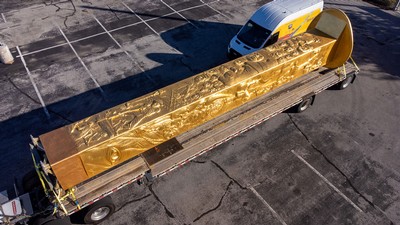Prof Explores Portable Harbors that Played Obscure but Vital Role in WWII
An aerial view of Mulberry Harbour B in September 1944, a year after it and its duplicate, Mulberry A, were instrumental in setting troops ashore in the Normandy invasion of D-Day. Professor Clint Flint discusses the historical ramifications of the artificial harbors in a new book. Photo from the collection of the Imperial War Museums.
In World War II, Britain and America built two full-size harbors, dragged them across the English Channel and hitched them in place at Normandy, France. That same day, thousands of Allied soldiers clambered onto the beaches of Normandy.
Now, we’re talking harbors, usually very large constructions that provide protective, wakeless enclosures for ships. So, why aren’t these portable, towable harbors that played such a vital role in the Normandy invasion a better-known fact of war history?
Colin Flint grew up in Dover, where the White Cliffs overlook the narrowest section of the English Channel, about 20 miles from France. Even he had heard very little about the temporary harbors. When, as an adult, he began to wonder more about this obscure corner of history, he looked at it from the viewpoint of a professor in USU’s political science department.
Thus, his new book, Geopolitical Constructs: The Mulberry Harbours, World War Two, and the Making of a Militarized Transatlantic.
It’s “harbours,” not “harbors,” notes this Brit, who came to the United States to attend grad school at the University of Colorado of Boulder and has never left. Flint is a geographer and expert in geopolitics and international relations.
The Mulberry Harbours were “artificial harbors that were dragged across the English Channel in the very wake of the invasion forces on D-Day,” said Flint.
These huge constructions — each “the size of Dover harbor,” Flint continued —“were there to make sure that if the initial D-Day landings were successful there would be enough men and material being put on the beach to ensure the breakout and sustained attack toward Berlin.”
Flint’s book, to be published in August by Rowman & Littlefield Publishers, argues that this little-known plank of history was the camel’s nose that allowed the United States to “project its military power” across the transatlantic route and import large-scale U.S. presence into Europe. One consequence — what Flint calls “an unintentional geopolitical implication” — was the Cold War that has, in large part, shaped our modern world.
Flint’s publisher puts it this way: Flint “offers a different way of thinking about war, one that sees war as an ongoing set of processes in which seemingly isolated acts are part of broader, historical developments.”
The harbors were look-alikes — Mulberry A constructed opposite the American landing site of Omaha Beach and Mulberry B opposite Britain’s Gold Beach. Concrete caissons for the harbor walls were built in floatable and sinkable segments that were tug-boated across the channel, as were pier-like roadways that floated up and down with the tide. Old ships were scuttled to make a breakwater. Even today, said Flint, remnants of the harbors can still be seen from Normandy beach.
In “Geopolitical Constructs,” Flint specifically looks at one entity that was “constructed,” or changed, by the development, manufacturing and use of the harbors — local British residents. The manufacture of the harbors was wound into Britain’s war machine, but the large, unwieldy bureaucracy it created equally affected southeast England’s workers, engineers and small-town governments.
In fact, Flint titled one chapter “Demanded by Strategy and Made by Committee.”
“That, of course, is a bit of an insult,” he said. “But they were made by committee because the army and the Navy both had their inter-service blinders on.”
Another construct explored by Flint is what he calls “the loss of British power and the imposition of American global power.”
The war marked the end of Britain as a world military power, a role it had expanded from the 16th century to the 20th century, and the parallel rise of the United States as a global power. Operation Bolero became the code name for the 1943 movement of more than a million American troops across the Atlantic into Britain. And, said Flint, “That would be pointless unless there was a way to get them across the English Channel. The Mulberry Harbours were an essential component of that movement.”
The Americans landed ashore in Europe in 1944 and basically never left, said Flint. The Normandy invasion efforts soon morphed into a pattern of occupation, in part creating the competition and hostility that would soon become known as the Cold War.
“The Mulberries played an interesting role in that,” said Flint. “They weren’t deterministic, but they played a role.”
Related links:
USU Political Science Department
USU College of Humanities and Social Sciences
Writer and contact: Janelle Hyatt, 435-797-0289, Janelle.hyatt@usu.edu
Colin Flint, a political science professor, has researched the artificial, portable harbors that allowed Allied troops to access Normandy beaches in World War II.
TOPICS
Research 878stories History 139stories Politics 72storiesComments and questions regarding this article may be directed to the contact person listed on this page.








